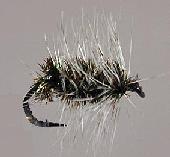 | brown hackle peacock ——————— hook: sz 12 dry fly hook thread: brown tail: about 8 barbs red dry fly hackle body: 2 strands peacock herl ribbing: tying thread, 4 or 5 turns wrapped back to tail over body, then 4 or 5 back forward wing: none hackle: I use brown DRY FLY hackle, tied wet style, I like the sheen notes: the ribbing is essential for durability top of page |
 | grey hackle peacock ——————— hook: sz 12 dry fly hook thread: brown tail: about 8 barbs red dry fly hackle body: 2 strands peacock herl ribbing: tieing thread like bhp wing: none hackle: grizzly notes: I sometimes tie a version with dark hackle tip wings, fewer rejections on flat water. I also tie a sz 16 wet version for small dark bodied flies, just one strand of herl for the body. From time to time I dab on a little floatant and fish it as a dry, also. top of page |
 | Griffith’s gnat ——————— hook: sz 16 dry fly hook thread: brown tail: none body: 2 strands peacock herl ribbing: tieing thread like bhp wing: none hackle: grizzly, palmered notes: This fly is easy to tie, floats like a cork, is easy to see, and catches fish. Some think it imitates a cluster of mating midges, I think it just makes a nice footprint on the water. I sometimes fish it for other hatches, and do ok, just because it’s so easy to see. top of page |
 | isonychia nymph ——————— hook: sz 8 bait hook thread: brown tail: bushy brown hackle cut off a little stubby body: 5 strands herl tied down and wrapped ribbing: tieing thread wrapped 5 or 6 turns back to tail, then 5 or 6 wraps back forward wing: none hackle: grizzly collar notes: Ribbing is essential for durability, I once tied these with a wing case and gold wire ribbing, but have simplified it out of laziness. The fish don’t care. top of page |
 | pheasant tail ——————— hook: sz 16 dry fly hook thread: brown tail: brown hackle body: 1/2 ply brown nylon yarn (works better for me than anything else) ribbing: none wing: none hackle: brown notes: Paul Ketron has submitted a pattern for a “proper” pheasant tail, as opposed to my dinky yarn bodied version. Check the “community flybox”. Thanks, Paul! top of page |
 | grey hackle yellow ——————— hook: sz 16 dry fly hook thread: brown tail: red dry fly hackle body: 1/2 ply nylon yarn, straw yellow ribbing: none wing: none hackle: grizzly notes: I sometimes tie a sz 12 version and use it during the white mayfly hatch. I also tie a sz 16 version with an orange body, fish it for sulfur or bwo spinners. top of page |
 | perla nymph ——————— hook: sz 8 bait hook thread: brown tail: brown hackle body: 1 ply brown nylon yarn wrapped candy cane style over 1 ply straw yellow nylon yarn, with an extra turn of brown for a thorax ribbing: none wing: none hackle: brown collar, all my nymphs are tied just with collars, no wingpad, ala Charlie Brooks notes: a tellico nymph would probably work as well, this is easier to tie top of page |
 | warpaint shiner ——————— hook: sz 8 bait hook thread: cream tail: grizzly hackle body: silver oval tinsel ribbing: fine gold wire wrapped counter to the tinsel wing: blonde part of raccoon tail hackle: none notes: build up head with thread, laquer, let dry, mark black eyes and red slashes with laundry markers. For shad I tie a white streamer with chicken feather wing and tail, tinsel body, and a head like the warpaint shiner. For sculpins and crayfish I use a “Jim Webb” wooly booger, brown tail, brown chennille body, palmered grizzly hackle wet style. I like to tie mine with peacock herl bodies. top of page |
About my flies: ——————— Learning to tie your own flies has several advantages. It greatly reduces the expense of fly fishing, and that is important to me. It also means you don’t have to worry about being able to find the flies you want in shops when you need them. Finally, it frees you to develop your own ties, based on your own ideas. About the only thing more thrilling than catching your first trout on a fly you tied yourself, is catching your first trout on a fly you designed and tied yourself! I only tie a handful of patterns, and don’t carry a lot of flies with me. My tying style is the product of my experiences and various inputs, magazine articles, the work of Art Flick, Charlie Brooks, and others. My criteria for good flies are the same as Art Flick’s: 1- they are easy to tie 2- they are made with cheap and available materials 3- they are durable (many of the flies you pay up to $2 for will tear up after 2 or 3 fish) 4- they catch trout! The patterns I use have been developed over the years, and work for me. Sometimes they work for others who try them, and sometimes not. You will develop your own preferences and style. That is as it should be. One reason this site has a message board is so that visitors can have access to a broader range of experience and style than just my own. From time to time folks have asked how to tie certain flies that I mention, and it is about time (4 March 2002) that I published the information. I am also setting up a community flybox page where others can share their favorite Hiwassee patterns. If you still have questions, feel free to post on the message board, or email me. Don Denney |